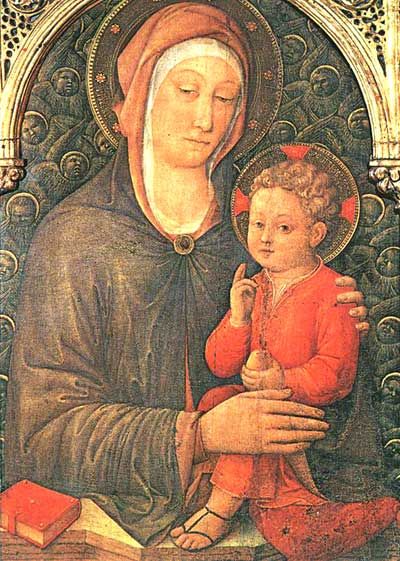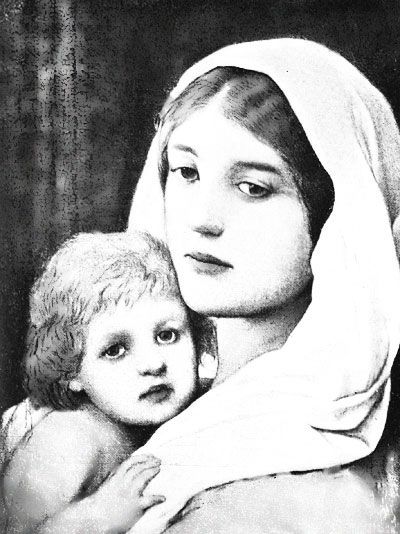









he first Madonna pictures known to us are of the portrait style, and are of Byzantine or Greek origin. They were brought to Rome and the western empire from Constantinople (the ancient Byzantium), the capital of the eastern empire, where a new school of Christian art had developed out of that of ancient Greece. Justinian's conquest of Italy sowed the new art-seed in a fertile field, where it soon took root and multiplied rapidly. There was, however, little or no improvement in the type for a long period; it remained practically unchanged till the thirteenth century. Thus, while a Byzantine Madonna is to be found in nearly every old church in Italy, to see one is to see all. They are half-length figures against a background of gold leaf, at first laid on solidly, or, at a somewhat later date, studded with cherubs. The Virgin has a meagre, ascetic countenance, large, ill-shaped eyes, and an almost peevish expression; her head is draped in a heavy, dark blue veil, falling in stiff folds.
Unattractive as such pictures are to us from an artistic standpoint, they inspire us with respect if not with reverence. Once objects of mingled devotion and admiration, they are still regarded with awe by many who can no longer admire. Their real origin being lost in obscurity, innumerable legends have arisen, attributing them to miraculous agencies, and also endowing them with power to work miracles. There is an early and widespread tradition, imported with the Madonna from the East, which makes St. Luke a painter. It is said that he painted many portraits of the Virgin, and, naturally, all the churches possessing old Byzantine pictures claim that they are genuine works from the hand of the evangelist. There is one in the Ara Coeli at Rome, and another in S. Maria in Cosmedino, of which marvellous tales are told, besides others of great sanctity in St. Mark's, Venice, and in Padua.
It would not be interesting to dwell, in any detail, upon these curious old pictures. We would do better to take our first example from the art which, though founded on Byzantine types, had begun to learn of nature. Such a picture we find in the Venice Academy, by Jacopo Bellini, painted at the beginning of the fifteenth century, somewhat later than any corresponding picture could have been found elsewhere in Italy, as Venice was chronologically behind the other art schools. The background is a glory of cherub heads touched with gold hatching. Both mother and child wear heavy nimbi, ornamented with gold. These points recall Byzantine work; but the gentler face of the Virgin, and the graceful fall of her drapery, show that we are in a different world of art. The child is dressed in a little tunic, in the primitive method.
 Jacopo Bellini.—Madonna and Child.
Jacopo Bellini.—Madonna and Child.Please click here for a modern color image
With the dawn of the Italian Renaissance, the old style of portrait Madonna passed out of vogue. More elaborate backgrounds were introduced from the growing resources of technique. In the fifteenth and sixteenth centuries, pictures of the portrait style were comparatively rare. Raphael, however, was not above adopting this method, as every lover of the Granduca Madonna will remember. His friend Bartolommeo also selected this style of composition for some of the loveliest of his works.
The story of the friendship between these two men is full of interest. At the time of Raphael's first appearance in Florence (1504), Bartolommeo had been four years a monk, and had laid aside, apparently forever, the brush he had previously wielded with such promise. The young stranger sought the Frate in his cell at San Marco, and soon found the way to his heart. Stimulated by this new friendship, Bartolommeo roused himself from lethargy and resumed the practice of art with increasing success. It is pleasant to trace the influence which the two artists exerted upon each other. The older man had experience and learning; the younger had enthusiasm and genius. Now it happened that, by nature, Bartolommeo was specially gifted in the arrangement of large compositions, with many figures and stately architectural backgrounds. It is by these that he is chiefly known to-day. So it is the more interesting that, when Raphael's sweet simplicity first touched him, he turned aside, for the time, from these elaborate plans and gave himself to the portrayal of the Madonna in that simplest possible way, the half-length portrait picture. Several of these he painted upon the walls of his own convent, glorifying that dim place of prayer and fasting with visions of radiant and happy motherhood. One of these may still be seen in the cell sometimes called the Capella Giovanato. It instantly recalls the Tempi Madonna of Raphael, both in the pose of the figure and in the genuineness of feeling exhibited. Damp and decay have warred in vain against it, and the modern visitor lingers before the Mother and Babe with hushed admiration.
Two other similar frescoes have been removed to the Academy. They show the same motherly tenderness, the same innocent and beautiful babyhood. The mother holds her child close in her arms, pressing her forehead to his, or bending her cheek to receive his kiss. He throws his little arm about her neck, clinging to her veil or caressing her face.
Besides this group of pictures by Bartolommeo, there are other scattered instances of portrait Madonnas during the Italian Renaissance, by men too great to be tied to the fashions of their day. Mantegna was such a painter, and Luini another. All told, however, their pictures of this sort make up a class too rare to deserve longer description.
A century later, the Spanish school occasionally reverted to the same style of treatment. A pair of notable pictures are the Madonna of Bethlehem, by Alonzo Cano, and the Madonna of the Napkin, by Murillo. Both are in Seville, the latter in the museum, the former still hanging in its original place in the cathedral.
Of Cano's work, a great authority[1] on Spanish art has written, that, "in serene, celestial beauty, it is excelled by no image of the blessed Mary ever devised in Spain." Murillo's picture is better known, and has a curious interest from its history. The cook in the Capuchin monastery, where the artist had been painting, begged a picture as a parting gift. No canvas being at hand, a napkin was offered instead, on which the master painted a Madonna, unexcelled among his works in brilliancy of color.
[1] Stirling-Maxwell, in "Annals of the Artists of Spain."

As the portrait picture was the first style of Madonna known to art, so, also, it is the last. By a leap of nearly a thousand years, we have returned, in our own day, to the method of the tenth century. It is strange that what was once a matter of necessity should at last become an object of choice. In the beginning of Madonna art, the limited resources of technique precluded any attempts to make a more elaborate setting. Such difficulties no longer stand in the way, and where we now see a portrait Madonna, the artist has deliberately discarded all accessories in order better to idealize his theme.
Take, for instance, the portrait Madonnas by Gabriel Max. Here are no details to divert the attention from motherhood, pure and simple. We do not ask of the subject whether she is of high or of low estate, a queen or a peasant. We have only to look into the earnest, loving face to read that here is a mother. There are two pictures of this sort, evidently studied from the same Bohemian models. In one, the mother looks down at her babe; in the other, directly at the spectator, with a singularly visionary expression. When weary with the senseless repetition of the set compositions of past ages, we turn with relief to a simple portrait mother like this, at once the most primitive and the most advanced form of Madonna art. It is only another case where the simplest is the best.